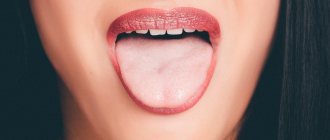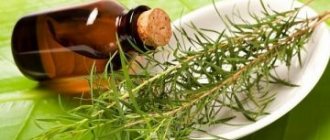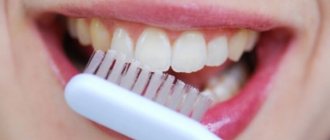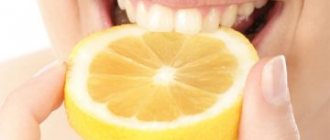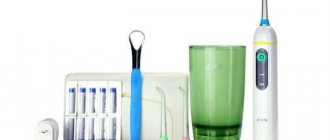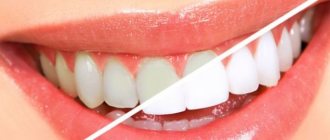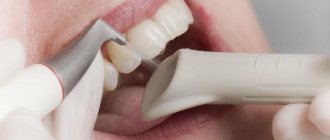Author of the article:
Soldatova Lyudmila Nikolaevna
Candidate of Medical Sciences, Professor of the Department of Clinical Dentistry of the St. Petersburg Medical and Social Institute, Chief Physician of the Alfa-Dent Dental Clinic, St. Petersburg
Many people cannot imagine their morning without a hot, invigorating drink. It seems that coffee can work wonders and literally bring you back to life. Gradually, the body gets used to any influence, therefore, in order to invigorate, more and more cups of this fragrant savior are required. But at some point we notice that the teeth acquire an increasingly intense yellow, and in some places even a brown tint.
What to do? Sound the alarm? Give up your favorite drink? Or should you put up with the picturesque patterns on your tooth enamel and just stop smiling?
All this, of course, is not an option. Moreover, today there are many ways to maintain healthy and white teeth without changing your habits. Let's figure out how coffee affects teeth, consider the most popular and effective methods that help get rid of plaque.
How does coffee affect enamel?
If you doubt whether coffee makes teeth yellow, look at the structure of the tooth. The enamel has pores where microparticles of coffee grounds penetrate. Because of this, dark spots appear. But some people have a smooth surface on their teeth. No staining deposits settle on their enamel and they can drink their favorite drink without harm.
Plaque on teeth from coffee is not only an external problem. As it accumulates, it begins to harden and turns into tartar. And this already leads to the appearance of periodontitis.
Reviews
Elizaveta P.: “I think it’s absolutely right when a smoker gives up a cigarette because his teeth turn black and crumble from smoking. Giving up your favorite coffee just because the enamel has become a little yellower is some kind of nonsense, an inferiority complex. I can’t imagine my day without a couple of cups of coffee. Well, about my teeth... I recently went for ultrasonic cleaning. The result is great."
Mila K.: “I’ll share some advice that I found in a women’s magazine. It turns out that it is useful to brush your teeth with milk powder. Blackness on the teeth does not make anyone look bad, and powdered milk can cope with any plaque; its benefit is also that tooth enamel is restored and cracks are healed. This means that you can safely drink coffee and eat different colored vegetables, for example, beets.”
Yuri V.: “In adult men, teeth deteriorate not because of coffee, tobacco is usually to blame. The yellow coating on them is not tea, but nicotine, which, of course, is much more harmful. But even nicotine can be defeated. For example, I always smoked a lot, my teeth turned yellow. I went to the dentist, where they made me mouth guards, which I had to wear for 2 hours for two weeks. The result is that the teeth became 4 shades lighter. I’m pleased myself, and the doctor thinks this is a good indicator.”
Causes of yellowness
Naturally, a small amount of coffee drink is not harmful to teeth. Natural dye is only dangerous for people who use it regularly.
In addition to the dye, the formation of stains after coffee drinks is affected by:
- Temperature. Drinking coffee hot is harmful. The pores expand and the coloring matter easily penetrates the enamel. The spots appear faster.
- Destructive acids that make up Arabica. There are more of them in this variety than in Robusta. Therefore, Arabica beans make teeth darken faster.
- Contrasting temperatures increase the risk of yellow discoloration. Therefore, in cold weather, do not drink coffee outdoors. And even more so in the cold. It is better to refuse a cocktail made from coffee with ice cream. This combination quickly destroys the tooth surface and makes it easier for the coloring matter to seep inside.
- Food residues on the teeth absorb and retain coffee particles. It turns out like a coloring lotion. If you don't take care of your mouth and don't brush your teeth well, they will turn yellow or dark.
As you can see, there are many reasons for yellowing. Coffee lovers should be more careful about hygiene.
Types of plaque
Soft deposits consist of pathogenic microflora: streptococci, staphylococci, lactobacilli, leptotrichia, etc., as well as their metabolic products. Among microorganisms there are those that contain a coloring pigment. Therefore, dental plaque can be colored in any color:
- white or slightly yellowish is formed due to poor hygiene;
- gray indicates a violation of mineralization processes;
- green indicates that the dust is dominated by bacteria whose waste products contain chlorophyll;
- yellow informs that the deposits have been pigmented by food dyes (tea, coffee, etc.);
- brown is formed in smokers or people who secrete iron that is not absorbed by the body in their saliva;
- black or dark brown is formed, as a rule, on milk teeth with a predominance of pigment-forming bacteria.
Can tint appear due to coffee with milk?
Some people add milk to the smoothie and believe that this way they reduce the effect of coffee on tooth enamel. There is a grain of truth in this.
Scientists conducted an experiment. They placed the extracted teeth in two containers. One had black espresso, the other coffee with milk. In black coffee, the tooth darkened, but in a drink without milk, the color did not change. This means that milk neutralizes the harmful effects of the dye.
But the ratio of components also affects. Too strong coffee with milk in small quantities harms your teeth more than a weak drink without milk.
Another reason to add milk is calcium, which is necessary for the strength of the tooth surface. The lack of substance also affects the appearance of the shade. Therefore, it is better for coffee lovers to choose between latte and cappuccino, and not overuse espresso.
Berries
Strawberries, raspberries, blueberries - all these berries are rich in vitamins and nutrients, incredibly tasty and everyone likes them. However, they can also speed up the yellowing of your teeth. Naturally, you shouldn’t refuse them in principle, but after eating it is recommended to rinse your mouth.
Frequent consumption of dark sauces, especially those with a sour taste, leads to the formation of stains on the teeth. In this regard, it is recommended not to consume these products frequently, and, if possible, switch to lighter dressings, such as rice sauce or lemon juice.
According to some studies, even herbal teas can stain tooth enamel, not to mention black tea, which contains tannins in large quantities. But at the same time, tea is a light bactericidal agent, which protects your teeth from the harmful effects of microorganisms.
Almost all sweet carbonated drinks contain large amounts of phosphoric acid. The high acidity of the drink destroys the enamel, and the dyes contained in soda (in particular, colored ones) easily penetrate deep into the enamel. In addition, carbonated drinks contain a number of harmful additives, which over time can lead to erosion processes.
What is more harmful: coffee or tea?
There is an opinion that tea is less harmful than a coffee cocktail. In fact, both drinks contain about the same amount of caffeine. This is discussed in detail in the article “Where is there actually more caffeine: in coffee or tea? Let's count."
From this we can conclude that the coloring effect of coffee and tea will be the same. The latter will also intensify if, after drinking, you rinse your mouth with preparations containing chlorhexidine.
Prevention
Compliance with preventive standards can reduce the risk of developing any dental disorders, including the formation of gray plaque.
For prevention purposes, the following rules should be followed:
- Timely brushing of teeth
- Refusal of coloring products (tea, coffee, alcohol, sweet drinks)
- Regular visits to the dentist
- Reducing the amount of carbohydrates consumed
- Prevent dry mouth
- Using rinse aids
- Using sugar-free chewing gum
Gray plaque is one of the most common dental problems caused by poor hygiene. To eliminate this violation, you should contact a dental clinic, where the contamination is removed through professional cleaning.
Is it possible to drink coffee after brushing and whitening your teeth?
We are sometimes asked how long after brushing our teeth we can start drinking coffee. But it all depends on what kind of cleaning you have in mind. After all, we can talk about a daily hygiene procedure or professional whitening from a specialist.
If you just brushed your teeth, you can drink coffee right away. Just remember to brush them at least twice a day and you'll be fine.
But to protect yourself from plaque after professional cleaning, refrain from drinking the drink for at least a day. For the second course you can drink a little latte. Then you can return to your normal routine.
Cleansing methods
The soft layer of contamination on dental elements is an excellent breeding ground for pathogenic microflora. It multiplies exponentially, becoming a source of infection and, as a result, the cause of caries, gum problems and gastrointestinal diseases. Dentists have learned to effectively deal with the problem. Once upon a time, cleansing was carried out manually, it was not effective enough and was accompanied by pain. Now, special devices are used for cleaning, which allow 100% destruction of pathogenic flora. Experts recommend doing this procedure at least once a year.
The most popular method is cleansing using an Air Flow device. Mechanism of action: a solution containing tiny abrasive particles is applied to the surface of the enamel layer under pressure. They gently “bombard” plaque, destroying it and washing it away. Hard tartar is removed with an ultrasonic scaler. Once cleaning is complete, the enamel is polished and a fluoride varnish is applied to remineralize it.
Important: self-medication is dangerous. Do not try to remove dirt with sharp objects (needle, knife, etc.). This is fraught with injury to the gums, chips, and the risk of swallowing the cleaning tool.
Coffee and healing procedures
After filling or implants, there are usually no restrictions on drinking espresso, but be sure to consult with your doctor.
Interesting! The benefits and harms of coffee for human health, its effect on the body and substitutes
But keep in mind that the filling material may be stained. Especially at first. Therefore, it is better to refrain from pure coffee. It is better to add milk during the day.
After tooth extraction, you can drink coffee within a few hours. But it is important to remember that it must be warm.
But before removal, drinking the drink is prohibited. This is due to the fact that caffeine weakens the effect of anesthesia.
How to drink correctly
There are several important tips on how to drink coffee to prevent your teeth from yellowing:
- drink only Americano or add milk or cream to the drink;
- Before drinking espresso, let it cool, hot water damages the enamel.
- after drinking any coffee drink, rinse your mouth with special rinses or at least warm water;
- Use professional products to clean your teeth.
These simple rules will reduce the harm of the coloring pigment.
How to remove coffee stains from teeth
Folk remedies
If stains have already appeared, there are several ways to deal with them or at least reduce the shade.
The following methods will help reduce the effect of coffee on your teeth.
Using a cotton pad or brush, rub baking soda into the enamel. Then rinse your mouth with plenty of warm water.
Grind the activated carbon tablet to a powder. Then brush your teeth and rinse your mouth thoroughly.
Hydrogen peroxide does an excellent job of removing plaque and yellowness. But be careful. The product can damage the enamel. At the first suspicion of a problem, use of peroxide should be stopped. You need to use the product to remove stains for at least two weeks. To do this, moisten a cotton pad with it and thoroughly wipe the teeth.
It is useful to use apple, lemon peel or strawberry for stains. First, you need to rub the crushed fruit on your teeth, and then brush them with a toothpaste containing fluoride. This method can be used no more than twice a month. Otherwise, the acids contained in fruits will damage tooth enamel.
Despite the benefits and apparent safety of folk remedies, you should be careful when using them. Therefore, before starting treatment, it is necessary to consult a doctor.
Interesting! How many cups of coffee can you drink per day?
Pharmacy products
Medicines purchased at the pharmacy will also help to cope with yellowness.
Use a paste with a whitening effect in combination with a brush with stiff bristles.
An electric brush can easily remove plaque that has recently appeared. The device works faster than manual cleaning, and therefore quickly eliminates the problem. Pay attention to the stubble. It shouldn't be too hard. Otherwise, you can damage the enamel and gums.
Whitening strips are used for at least two weeks. They are glued to problem areas of the enamel and kept for about 30 minutes. The downside of the product is its high cost.
Gels with a whitening effect are considered effective and at the same time safe ways to cope with yellowness. Before applying the gel, your teeth must be thoroughly cleaned. Apply a small amount of product to a clean surface. Then you should wait until the drug dissolves. The procedure is repeated for two weeks.
The sticks gently and carefully whiten the enamel. But they are used to prevent plaque, and not to fight it. Therefore, they should be used immediately after drinking espresso.
Whitening trays are effective in fighting stains. They can even handle old yellow stains. It is necessary to use the method strictly following the instructions for use. Overuse of mouthguards destroys enamel.
You can remove plaque at home only after consulting a doctor.
He will be able to advise you on the best method to suit your teeth specifically.
A method for the lazy
For lazy people who want quick results and not waste time and effort on each cup, there is this method:
- take an enamel pan, fill 5-6 liters of cold water (so that all the dishes are covered with water);
- pour soda (per 1 liter of water - 1 tablespoon of soda);
- we put all the cups that need to be washed in a saucepan (you can use not only cups, but also any dishes that have plaque on them) and put them on the stove;
- wait until the water boils, turn down the heat and wait another half an hour;
- after which, turn off the stove, wait until the water cools down a little and take out the dishes. You will be very surprised at the good results.
If you decide to put the cups in the dishwasher, there will be no result, since it washes the dishes superficially and is not suitable for combating plaque.

